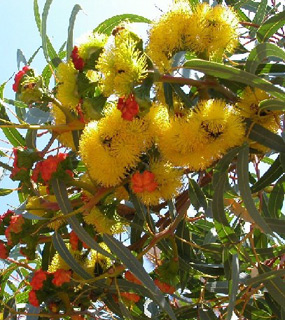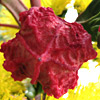Eucalyptus erythrocorys is a small tree, 3-10m tall mallee (a multi-stemmed shrub form), adapted to resprout after fires from a partially exposed lignotuber (a burllike woody base). The bark is smooth creamy with a few rough patches of loose brown bark.
Adult leaves of illyarrie are leathery sclerophylls-tough, thick, and sturdy-and have the same texture as a 4-by-6 note card, which can be snapped without tearing. These glossy green leaf blades are lance-shaped, 2 to 4 cm wide near the base and up to 26 cm in length, sickle-shaped (i.e., falcate), and curved back toward the stem. Leaf arrangement is opposite, occasionally subopposite, along the reddish young stems. In contrast, juvenile leaves are ovate and much shorter, as compared with adult leaves twice as wide and half as long, thinner and not as tough, and with a straight, not curved, axis; these blades are dull green and both surfaces are conspicuously hairy. Juvenile leaves are produced on rapidly elongating suckers with very long stem internodes arising from the lignotuber, and thereafter only adult leaves are produced. Crushing a leaf produces the faint odor of turpentine,
Flowering occurs from late summer to early autumn. The flowers are preceded by large rectangular scarlet buds covered by a bright-red cap (operculum) in bud - giving the epithet erythrocorys (red-helmet). The cap abscises when the flower opens, and is comprised of fused perianth parts. The red helmet is unique for the genus Eucalyptus and, therefore, this species is distinctive and unmistaken in a genus where identifications can be extremely difficult. In E. erythrocorys, the colorful red cap contrasts with the green ovary and 1500 bright yellow stamens-among the highest number of all angiosperms. Its big flowers are produced from axillary buds, generally as paired lateral inflorescences, each bearing 2 or 3 flowers. The flowers are exceptionally wide, being squarish in face view and measuring up to 7.5 cm corner to corner. When all 6 flowers from the node are open, the yellow display is dazzling. Stamens are attached along the floral disk, most formed in raised puffs at the four corners, opposite four ridges atop the segments (carpels) of the ovary.The strongly ribbed, green ovaries are inferior and form a single style from the sunken apex of the ovary.
Fruits of the red cap gum are woody and massive capsules (4 to 5 cm diameter), bell-shaped, and strongly ridged, and the depressed center of the fruit is glossy red. Dried stamens often persist on the maturing fruits, and fruits eventually open at the top via four splits. There may be so many of the large helmet-shaped fruits that they weigh the tree down.
It is native to Western Australia North of Perth on undulating limestone from Geraldton to Shark Bay. It commonly grows on limestone soils and is well adapted to alkaline conditions. It responds well to pruning. Propagation is from seed which germinates readily.
It was introduced to Israel to serve as a honey plant, to supply the honeybees food at the time of year when almost no other plants bloom in this country.
Written by Amram Eshel






